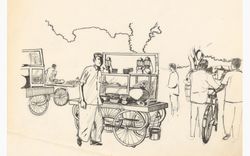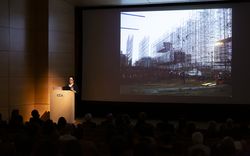5,000 Species of Trees
On conservation and recovery of Brazil’s Atlantic Forest
The text and images that follow are excerpted from With an Acre, the third and final chapter of the Groundwork exhibition and film series which ends on 12 October.
The Atlantic Forest is home to nearly 5,000 species of trees. However, 80% of the endemic species are endangered and several are already extinct.
Henrique Lahmeyer de Mello Barreto. Native flora of Minas Gerais (selection based on species identified in environmental monitoring by Flor de Café near Nepomuceno), ca. 1935. Courtesy of The Field Museum, Chicago. From left to right: Ocotea odorifera Rohwer, Cassia ferruginea Schrad., Piptadenia gonoacantha.
Henrique Lahmeyer de Mello Barreto (1892–1962) was the founding director of the Botanical Garden in Belo Horizonte, the capital of Minas Gerais. Over the course of his career, he collected thousands of plant specimens across Brazil, many of which were named in his honour. As a professor of natural history and agronomy, Mello Barreto (as he was affectionately called) taught across disciplines ranging from agricultural engineering to medicine, and his research laid the foundations for modern Brazilian environmental science.
Henrique Lahmeyer de Mello Barreto. Native flora of Minas Gerais (selection based on species identified in environmental monitoring by Flor de Café near Nepomuceno), ca. 1935. Courtesy of The Field Museum, Chicago. From left to right: Matayba elaeagnoides, Platycyamus regnellii, Zanthoxylum rhoifolium.
He was also a close friend and adviser to Roberto Burle Marx, with whom he collaborated on the gardens at Pampulha (1943) and other projects in Minas Gerais that allowed Burle Marx to experiment with local flora. Mello Barreto helped shape a Brazilian school of urban planning and landscape design committed to ecological balance. His collections are housed in herbaria around the world.
After centuries of pressures, including urbanization, industrialization, and agriculture—in Minas Gerais, mainly coffee plantations—the Atlantic Forest has been reduced to 15% of its original coverage. Coffee arabica, native to the forests of South Ethiopia, was first planted in Brazil in 1727 by the Portuguese. The expansion of coffee plantations along the country’s southern coast led to the decimation of large areas of the Forest. Today, the industry covers 2 million hectares.
Henrique Lahmeyer de Mello Barreto. Native flora of Minas Gerais (selection based on species identified in environmental monitoring by Flor de Café near Nepomuceno), ca. 1935. Courtesy of The Field Museum, Chicago. From left to right: Tapirira guianensis, Vochysia tucanorum, Copaifera langsdorffii (Copaiba).
Although some legislation exists to protect the critically-threatened forest, conservation and recovery remain immense challenges that require raising collective awareness and transforming agricultural practices, particularly in the face of escalating climate change.
Lélia Wanick and Sebastião Salgado set an important example for rehabilitating this forest with the establishment of a non-profit organization to restore their family property in the Rio Doce valley, which had been degraded by cattle ranching. Since 1999, Instituto Terra has planted over three million trees on 600 hectares of land. The reforested property has now been designated a natural heritage reserve and is seeing the return of rare flora and fauna. Today, Instituto Terra partners with smallholder farmers to plant and grow native seedlings, providing educational programs and professional training to support rural development with an ecological focus.

















